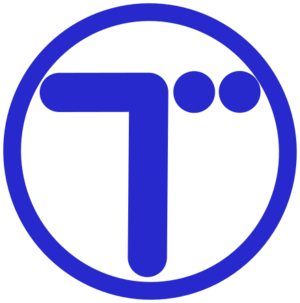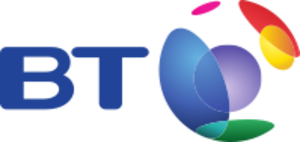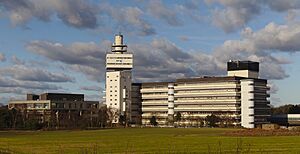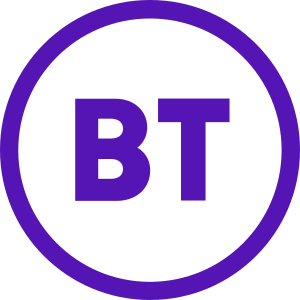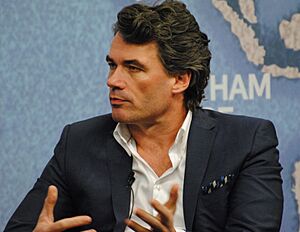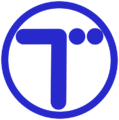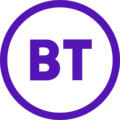BT Group facts for kids

BT Group's logo since 2022
|
|
|
Formerly
|
British Telecom |
|---|---|
| Public | |
| Traded as |
|
| Industry | Telecommunications |
| Predecessor |
|
| Founded | 18 June 1846 (foundation of the Electric Telegraph Company) 1 January 1912 (National Telephone Company system take-over under the General Post Office) 1 October 1969 (as a public corporation under the Post Office) 1 October 1981 (as a public corporation under the British Telecom brand) 1 April 1984 (as a private company) |
| Headquarters | One Braham,
,
England, UK
|
|
Area served
|
Worldwide |
|
Key people
|
|
| Products |
|
| Revenue | |
|
Operating income
|
|
| Owner |
|
|
Number of employees
|
98,800 (2023) |
| Divisions |
|
| Subsidiaries |
|
BT Group plc, also known as BT, is a big company from the UK. It helps people connect all over the world. BT is based in London, England. It works in about 180 countries. In the UK, BT is the biggest company for landline phones, internet, and mobile services. It also offers TV and IT services.
BT's story began in 1846 with the Electric Telegraph Company. This was the world's first public company for telegraphs. It built a communication network across the country. BT Group as we know it started in 1912. This was when the General Post Office (GPO), a government department, took over the National Telephone Company. This made the GPO the only phone service provider in the UK.
In 1969, the GPO became a public company called Post Office Telecommunications. The name British Telecom was first used in 1980. It became a separate company from the Post Office in 1981. In 1984, British Telecom became a private company. About half of its shares were sold to people who wanted to invest. The government sold its remaining shares in 1991 and 1993. BT is listed on the London Stock Exchange. It is one of the top 100 companies in the UK.
BT has several important parts. Its BT Business section provides phone and internet services to companies and governments worldwide. The BT Consumer section offers phone, internet, and TV services to about 18 million customers in the UK.
How BT Started and Grew
Early Telegraphs
Many private companies offered electrical telegraph services in the UK starting in 1846. These included:
- Electric Telegraph Company: This was the world's first public telegraph company. It built a communication network across the country.
- British and Irish Magnetic Telegraph Company
- British Telegraph Company
- London District Telegraph Company
- United Kingdom Telegraph Company
The General Post Office Takes Over
In 1868, the government took control of all these telegraph companies. They became part of the General Post Office (GPO). In 1869, the GPO was given the only right to provide communication services.
When the telephone was invented in 1876, the GPO started offering phone services. In 1882, the Postmaster-General began giving licenses to private companies. This allowed them to offer phone services too. The National Telephone Company (NTC) became the GPO's main competitor. It bought up other private phone companies. By 1912, the NTC was taken over by the GPO. This made the GPO the main phone service provider.
The GPO took control of the main phone lines in 1896. It took over local phone networks in 1912. A few towns, like Kingston upon Hull and Portsmouth, kept their own phone services. Hull still has its own independent phone company today.
Post Office Telecommunications
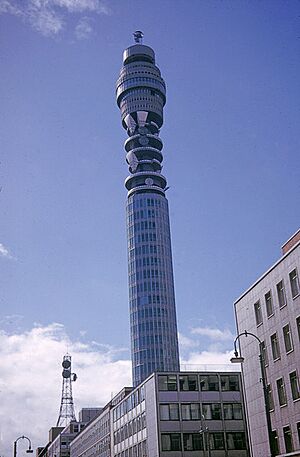
In 1969, the GPO became a national company called the Post Office. Post Office Telecommunications was created as a part of the Post Office in October 1969. This change aimed to make postal and phone services more efficient. Each part could focus on its own services.
The 1970s were a time of big growth for the Post Office. Most phone exchanges were updated and expanded. Many services, like direct dialing for long distance and international calls, became available. By the end of the 1970s, people could dial directly to most parts of the world. The System X digital phone system was developed. The first digital exchanges began to be installed.
British Telecom is Born
In 1979, the government decided that phone services should be completely separate from the Post Office. The British Telecom name was introduced in 1980. On October 1, 1981, it became the official name of Post Office Telecommunications. It became a government-owned company. In 1982, British Telecom's control over phone services ended. Another company, Mercury Communications, was allowed to offer services.
Becoming a Private Company
On July 19, 1982, the government announced it would sell shares in British Telecom to the public. On April 1, 1984, British Telecommunications became a public limited company (plc). This happened before the Telecommunications Act of 1984 was passed. The new law allowed British Telecom to become a private company.
In November 1984, just over half of the new company's shares were sold to the public and employees. The shares were listed in London, New York, and Toronto. Trading began on December 3, 1984. The government sold its remaining shares in 1991 and 1993. In 1997, the government gave up its "Golden Share." This share had allowed it to stop a takeover of the company.
The company changed its trading name to "BT" on April 2, 1991.
Expanding Services
In the early 1980s, BT Merlin was created. It sold products like phone systems to small businesses. Later, it offered desktop computers with built-in modems.
In the 1990s, BT entered the Irish phone market. It worked with the Electricity Supply Board. This partnership, called Ocean, became successful by launching Ireland's first free dial-up internet service. BT bought all of Ocean in 1999.
From 1980 to 2000, BT and other companies started offering internet services as they became popular.
Global Partnerships
BT tried to form big partnerships with other global phone companies.
In 1994, BT and MCI Communications started a joint project called Concert Communications Services. They wanted to build a global network for large companies. In 1996, they planned to merge and create a new company called Concert plc. However, the deal did not happen. BT sold its part of MCI in 1998.
BT still wanted to reach the North American market. So, in 1998, it partnered with AT&T. This partnership also faced problems and ended in 2001. BT kept some of the global network assets.
BT Ireland
In 2000, BT bought Esat Telecom Group plc and Ireland On Line. It also bought Telenor's shares in Esat Digifone. Esat Telecom Group was split. The landline and internet parts joined BT Ignite. Esat Group was renamed Esat BT in 2002, and then BT Ireland in 2005. Esat Digifone became part of BT Wireless. It later became a separate company called mmo2 plc (now Telefónica Europe).
Solving Debt Problems
By 2001, BT had a lot of debt, about £30 billion. Much of this debt came from bidding for 3rd generation mobile phone licenses. BT also had problems with its global mergers. Its share price dropped a lot.
To fix this, BT raised £5.9 billion in May 2001. It also sold parts of its business. It sold its shares in Japan Telecom, J-Phone Communications, and Airtel of India to Vodafone. In June 2001, BT sold its directory business, Yell Group, for £2.1 billion.
In November 2001, BT's mobile phone business, BT Cellnet, became a separate company called "mmO2". This included BT's mobile networks in other countries. All networks owned by mmO2 were later renamed O2.
After these changes, Sir Peter Bonfield resigned as CEO in October 2001. Ben Verwaayen took his place. In 2005, mmO2 plc was bought by Telefónica for £18 billion.
In 2004, BT launched Consult 21. This was a plan to help BT switch to a new digital phone network. In 2005, BT bought several companies, including Infonet and Albacom. It also bought Radianz from Reuters. In 2006, BT bought the online electronics store Dabs.com.
In October 2006, BT announced it would invest £10 billion over five years. This money would go into its new Internet Protocol (IP) based network, called the 21st Century Network (21CN). This new network was expected to save £1 billion each year.
From 2007 to 2012
In January 2007, BT bought PlusNet plc, an internet service provider. This added 200,000 customers. PlusNet continued to operate from its office in Sheffield. In February 2007, BT bought International Network Services Inc. (INS). This company provides IT advice and software.
In February 2007, Sir Michael Rake became the new chairman. In April, BT bought COMSAT International. In October, it bought Lynx Technology.
BT bought Wire One Communications in June 2008. This company was added to BT's video conferencing unit. In July 2008, BT bought Ufindus, an online business directory firm. This helped BT grow in the local information market. On July 28, 2008, BT bought Ribbit. Ribbit helped web developers add phone features to their online apps.
BT started rolling out fibre broadband. It planned to deliver fibre-to-the-premises (FTTP) to about 25% of the country. The rest would get fibre-to-the-cabinet (FTTC), which uses copper wires for the last part of the connection. By 2014, less than 0.7% of BT's fibre network was FTTP. BT then changed its plans. It said FTTC speeds had improved, so the 25% FTTP target was "far less relevant."
On April 1, 2009, BT Engage IT was created. It combined two earlier BT purchases, Lynx Technology and Basilica. In May 2009, BT announced it would cut up to 15,000 jobs. In July 2009, BT offered workers long holidays or payments if they agreed to work part-time.
On April 6, 2011, BT launched BT MyDonate. This was a free online fundraising service for UK charities. It passed on 100% of donations to the charity. BT developed MyDonate with help from charities like Cancer Research UK and NSPCC.
From 2013 to 2020
In March 2013, BT was given 4G mobile network space in the UK. It paid £201.5 million for this.
On August 1, 2013, BT launched its first TV channels, BT Sport. This was to compete with Sky Sports. BT had won the rights to broadcast 38 Premier League football matches each season. In February 2013, BT bought ESPN Inc.'s UK and Ireland TV channels. This helped BT expand into sports broadcasting. On November 9, 2013, BT announced it had won the rights to show the UEFA Champions League and Europa League for £897 million. This started from the 2015 season.
On November 1, 2014, BT created a new central business services group. This was to improve customer service and efficiency.
On November 24, 2014, BT's shares went up. This was because the company was talking about buying back O2. At the same time, it was also talking about buying EE. BT later agreed to buy EE for £12.5 billion on February 5, 2015. This deal combined BT's 10 million customers with EE's 24.5 million mobile customers. Deutsche Telekom would own 12% of BT, and Orange S.A. would own 4%.
In March 2015, BT launched a 4G mobile service called BT Mobile. BT Group CEO Gavin Patterson announced that BT planned to move all its customers to the IP network by 2025. This meant turning off the company's older ISDN network.
On January 15, 2016, BT received approval to buy EE. The deal was completed on January 29, 2016. Deutsche Telekom then owned 12% of BT, and Orange S.A. owned 4%.
On February 1, 2016, BT announced a new company structure. The EE brand and stores became a second consumer division. It worked alongside BT Consumer to offer mobile, broadband, and TV services. A new BT Business and Public Sector division was created. It served small and large businesses and the public sector in the UK and Ireland. There was also a new BT Wholesale and Ventures division.
In June 2017, BT chose KPMG as its new auditor. This happened after a fraud scandal in Italy. On July 8, 2017, The Daily Telegraph reported that BT was reviewing its businesses to save money. On July 28, 2017, BT announced more changes. It combined its BT Consumer and EE divisions into one new BT Consumer division. This started on April 1, 2018.
On April 18, 2018, BT announced further changes. It combined its BT Business and Public Sector and BT Wholesale and Ventures divisions. This created a new division called BT Enterprise. This started on October 1, 2018.
From 2021 to Today
In February 2021, BT and EE launched a home broadband service. It could also use the mobile network. If customers lost their internet connection, their device would automatically connect to EE's mobile network. This gave them an "unbreakable" connection.
In June 2021, a French company called Altice bought a 12% share in BT. This increased to 18% in December 2021 and 24.5% in May 2023. This raised questions about the UK's national security. The UK government investigated in May 2022. In August 2022, the government decided that the investment did not pose any national security risks.
In July 2023, BT announced that Allison Kirkby would become its new chief executive. She took over in February 2024.
In June 2024, Carlos Slim bought a 3.2% share in BT. Two months later, Sunil Mittal's Bharti Enterprises bought Altice's 24.5% share for about £3.2 billion.
How BT Works
BT Group is a holding company. Most of its businesses are owned by its company, British Telecommunications plc. BT's businesses are regulated by the British phone regulator, Ofcom. BT has a lot of power in some markets. In these markets, BT must follow extra rules. For example, it must provide services when asked and treat all companies fairly.
BT manages the phone exchanges, main network, and local connections for most UK landline phones. Except for KCOM Group in Kingston upon Hull, BT is the only UK phone company that must provide a landline to any address in the UK at the same price. This rule also covers phone directories and public phone boxes. In 2018, a rule was added for a minimum standard of broadband service.
BT also offers more profitable products and services. These include broadband internet and special solutions for phone and IT needs.
BT's Brands
In 2019, a simpler BT logo and brand were launched. In April 2022, BT announced it would focus on the EE brand for products sold to customers.
Company Information
Buildings and Places
BT works in about 180 countries. It owns and rents many buildings and facilities. In 2001, it sold some of its UK properties for £2.38 billion. This helped BT reduce its debt.
Main Office
Until December 2021, BT Group's main office was the BT Centre in London. In November 2021, BT moved to a new main office at One Braham. This is a new 18-story building. In March 2024, BT Group opened a new office in Cardiff, Wales, for 1,000 employees.
Important Buildings
Some of BT's important buildings and stations in the UK are:
- Adastral Park: This is where BT Labs is located.
- The Assembly: A building in Bristol.
- Baynard House: A building in London.
- BT Riverside Tower: BT Northern Ireland's main office in Belfast.
- BT Tower: A building in Swansea.
- Goonhilly Satellite Earth Station: A satellite station in Cornwall.
- Guardian telephone exchange: A phone exchange in Manchester.
- Madley Communications Centre: A satellite station in Herefordshire.
- National Network Management Centre: A network control center in Shropshire.
- Stadium House: A building in Cardiff.
Phone Towers
BT owns many telecommunications towers in the UK. These towers were important for its microwave network. The BT Tower in London was the tallest building in the UK from the 1960s to the early 1980s. It had a spinning restaurant at the top. It is still a very important communication center. It carries about 95% of the UK's TV content. Some of BT's towers are:
- BT Tower in London
- BT Tower in Birmingham
- Charwelton BT Tower in Northamptonshire
- Heaton Park BT Tower in Manchester
- Morborne Hill BT Tower in Cambridgeshire
- Purdown BT Tower in Bristol
- Pye Green BT Tower in Staffordshire
- Stokenchurch BT Tower in Buckinghamshire
- Sutton Common BT Tower in Cheshire
- Tinshill BT Tower in West Yorkshire
- Tolsford Hill BT Tower in Kent
- Turners Hill BT Tower in West Midlands
- Wotton-under-Edge BT Tower in Gloucestershire
- Zouches Farm in Bedfordshire
Other Facilities
Some of BT's other UK facilities are:
- Red telephone box: The original red phone boxes.
- KX telephone boxes: Newer versions of the red phone boxes.
- LinkUK: Modern kiosks that replace phone boxes and offer free services.
- TAT-14: A transatlantic telecommunications cable system.
BT's Main Parts
BT Group is divided into these main parts:
For Customers
- BT Consumer: Provides phone, internet, and TV services to people in the UK. This includes:
- BT Broadband
- EE Broadband
- EE Mobile
- EE TV
- EE WiFi
- Plusnet: An internet provider that offers mobile and fixed services.
- TNT Sports: A sports TV channel (jointly run with Warner Bros. Discovery).
- BT Business: Provides products and services to small, medium, and large businesses. It also serves government groups in the UK and worldwide. This part was formed by combining BT Enterprise and BT Global Services.
- Openreach: This is a separate part of BT. It was created in 2005. It has 25,000 engineers who used to work for BT. Its job is to make sure other phone companies have the same access to BT's network. It is responsible for installing and fixing the "last mile" of copper wire connections.
Internal Services
- Networks: This team designs, builds, and runs the networks and technology platforms that BT and its customers use.
- BT Research
- Digital: This team leads BT's digital changes. It creates new products and services for customers.
- BT's "BT Sourced" team buys things for the company. It was started in February 2021 and is based in Dublin.
Company Leadership
BT's main leaders as of November 2021:
- Adam Crozier: Chairman
- Allison Kirkby: Chief Executive
- Simon Lowth: Group Chief Financial Officer
- Marc Allera: CEO of BT Consumer
- Bas Burger: CEO of BT Global Services
- Sabine Chalmers: General Counsel
- Gerry McQuade: CEO of BT Enterprise
- Ed Petter: Corporate Affairs Director
- Cathryn Ross: Director of Regulatory Affairs
- Michael Sherman: Chief Strategy and Transformation Officer
- Howard Watson: Chief Technology and Information Officer
- Alison Wilcox: HR Director
- Dan Fitz: Company Secretary
- Clive Selley: CEO of Openreach
Pension Plan
BT has one of the largest pension plans for its employees in the UK. This plan helps employees get money when they retire. The plan was valued at £36.7 billion at the end of 2010. The plan closed to new members in 2001. It closed to most members for earning new benefits in 2018. As of June 30, 2025, the plan had £35.7 billion in assets.
Sponsorships
BT has sponsored many sports and events.
- From 1999 to 2006, BT sponsored Scotland's rugby union championships.
- In July 2012, BT agreed to sponsor Ulster Rugby for three years. BT's logo appeared on their rugby shirts.
- In July 2013, BT partnered with Scottish Rugby Union. It sponsored two professional rugby clubs, Edinburgh Rugby and Glasgow Warriors. BT Sport became their shirt sponsor.
- In May 2014, BT joined Sky, TalkTalk, and Virgin Media. They became founding partners of Internet Matters. This group gives online safety advice to parents and children.
- In May 2014, BT agreed to a £20 million sponsorship deal with Scottish Rugby Union. This included naming rights for Murrayfield Stadium, which became BT Murrayfield Stadium. BT also sponsored the Scotland sevens team and domestic rugby competitions.
- In April 2015, BT increased its sponsorship with Scottish Rugby Union. It became the new shirt sponsor for the Scotland national teams.
- In January 2016, BT and YouTube became main sponsors of the Edinburgh International Television Festival.
- BT is a main partner of the Wayne Rooney Foundation. This foundation helps children and young people. BT Sport showed Wayne Rooney's testimonial match in August 2016. BT MyDonate was the official fundraising platform for the event.
- In May 2017, BT sponsored the 2017 British Urban Film Festival. BT hosted the events at the BT Tower.
- In September 2017, BT extended its sponsorship deal with Scottish Rugby Union for three more years. BT kept the naming rights to BT Murrayfield Stadium. It also remained the main partner of the Scotland national team.
Images for kids
See also
 In Spanish: BT Group para niños
In Spanish: BT Group para niños


